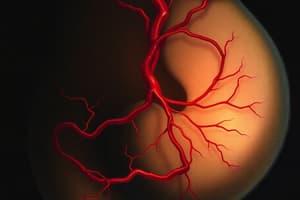Podcast
Questions and Answers
What is the most common site for coronary artery disease?
What is the most common site for coronary artery disease?
- Left ventricle
- Left atrium
- Right atrium (correct)
- Coronary sinus
What structure serves as a remnant of the umbilical vein in the liver?
What structure serves as a remnant of the umbilical vein in the liver?
- Ligamentum teres (correct)
- Fossa ovalis
- Ligamentum arteriosum
- Pectinate muscle
In which phase does the body primarily engage in 'rest and digest'?
In which phase does the body primarily engage in 'rest and digest'?
- Endocrine response
- Sympathetic response
- Parasympathetic response (correct)
- Muscular response
Which structure is primarily responsible for the flow of blood from the right ventricle to the lungs?
Which structure is primarily responsible for the flow of blood from the right ventricle to the lungs?
What is the primary role of the pectinate muscle in the heart?
What is the primary role of the pectinate muscle in the heart?
What is the primary function of the heart in the circulatory system?
What is the primary function of the heart in the circulatory system?
Which part of the heart receives deoxygenated blood from the body?
Which part of the heart receives deoxygenated blood from the body?
What is the role of the left ventricle in the cardiovascular system?
What is the role of the left ventricle in the cardiovascular system?
Which valves are responsible for regulating blood flow between the atria and ventricles?
Which valves are responsible for regulating blood flow between the atria and ventricles?
What type of blood is sent from the right ventricle to the lungs?
What type of blood is sent from the right ventricle to the lungs?
How does the left atrium receive blood?
How does the left atrium receive blood?
Which structure carries oxygenated blood away from the heart?
Which structure carries oxygenated blood away from the heart?
Which major blood vessel returns deoxygenated blood to the right atrium?
Which major blood vessel returns deoxygenated blood to the right atrium?
Flashcards
Coronary Artery Disease
Coronary Artery Disease
A condition where the arteries supplying blood to the heart become narrowed or blocked.
Myocardial Infarction
Myocardial Infarction
A heart attack; the blockage of blood flow to part of the heart muscle.
Right Atrium
Right Atrium
The upper right chamber of the heart, receiving deoxygenated blood from the body.
Left Ventricle
Left Ventricle
Signup and view all the flashcards
Fossa Ovalis
Fossa Ovalis
Signup and view all the flashcards
Heart Chambers
Heart Chambers
Signup and view all the flashcards
Blood Flow (Simple)
Blood Flow (Simple)
Signup and view all the flashcards
Oxygenated Blood
Oxygenated Blood
Signup and view all the flashcards
Deoxygenated Blood
Deoxygenated Blood
Signup and view all the flashcards
Valves in Heart
Valves in Heart
Signup and view all the flashcards
Blood Vessels (Arteries/Veins)
Blood Vessels (Arteries/Veins)
Signup and view all the flashcards
Atria vs Ventricles (Function)
Atria vs Ventricles (Function)
Signup and view all the flashcards
Pulmonary Circulation
Pulmonary Circulation
Signup and view all the flashcards
Study Notes
Fetal Circulation Overview
- Fetal circulation differs from postnatal circulation due to the non-functioning lungs and reliance on the mother for nutrients and waste removal
- A fetus requires a system for transporting oxygen and nutrients from the mother to the fetus and waste products away from the fetus
Placenta
- The placenta is an organ that develops alongside the fetus in the uterus to facilitate communication between maternal and fetal blood
- This communication occurs via umbilical vessels in the umbilical cord
- Oxygen and nutrients are transported in the umbilical vein to the fetal heart
- Deoxygenated blood is transported from the fetal heart to the placenta via umbilical arteries
Umbilical Vein
- Oxygenated blood travels from the placenta through the umbilical vein to the fetal circulatory system
- The vessel regresses to form the ligamentum teres, a structure of the liver found on the inferior edge of the falciform ligament
Umbilical Arteries
- Deoxygenated blood travels from the fetal heart to the placenta through the two umbilical arteries
- The arteries carry blood away from the fetal heart
Foramen Ovale
- The foramen ovale is a hole that shunts blood from the right atrium to the left atrium, bypassing the lungs
- A small amount of blood flows through the lungs to support the tissue
- The foramen ovale closes after birth, creating the fossa ovalis
Ductus Arteriosus
- The ductus arteriosus diverts blood from the pulmonary artery to the aorta, bypassing the lungs
- After birth, this vessel closes, forming the ligamentum arteriosum
Coronary Circulation
- The heart's own blood supply is called coronary circulation
- Blood flow occurs when the heart is relaxed (diastole)
- Heart contraction (systole) prevents much blood flow to the myocardium
- Entrances to the coronary circulation are partially blocked by the open aortic semilunar valve
Coronary Arteries
- Right Coronary Artery
- R Marginal Artery
- Posterior Interventricular Artery
- Left Coronary Artery
- Anterior Interventricular Artery
- Circumflex Artery
Coronary Veins
- They carry deoxygenated blood back towards the heart
- Coronary Sinus: largest vein
- Middle Cardiac Vein
- Small Cardiac Vein
- Great Cardiac Vein
Intrinsic Conduction System
- The heart contains specialized cells that initiate and distribute electrical signals
- These signals induce heart contraction
- Consists of:
- Sinoatrial (SA) node is the pacemaker
- Atrioventricular (AV) node
- Atrioventricular (AV) bundle
- Bundle branches
- Purkinje fibers
Heart Rate Regulation
- Sympathetic stimulation increases heart rate
- Parasympathetic stimulation decreases the heart rate
Heart Sounds
- Two heart sounds, S1 and S2
- S1 results from closure of the AV valves
- S2 results from closure of the semilunar valves
Studying That Suits You
Use AI to generate personalized quizzes and flashcards to suit your learning preferences.




